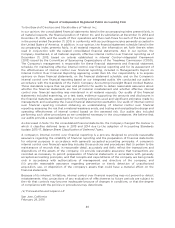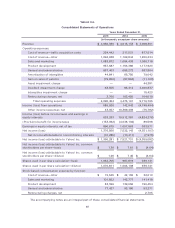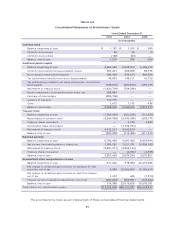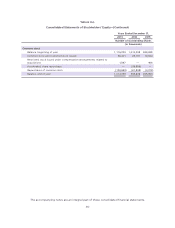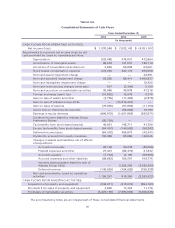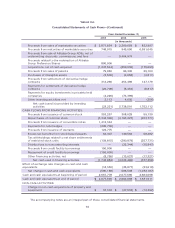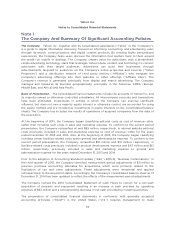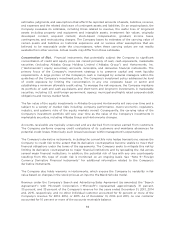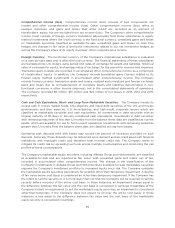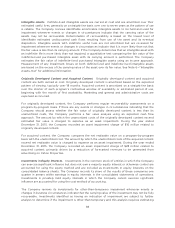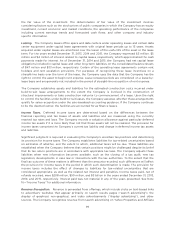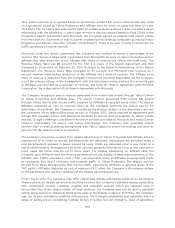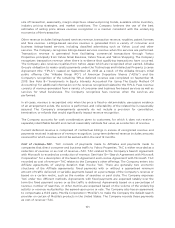Yahoo 2015 Annual Report Download - page 98
Download and view the complete annual report
Please find page 98 of the 2015 Yahoo annual report below. You can navigate through the pages in the report by either clicking on the pages listed below, or by using the keyword search tool below to find specific information within the annual report.estimates, judgments, and assumptions that affect the reported amounts of assets, liabilities, revenue,
and expenses and the related disclosure of contingent assets and liabilities. On an ongoing basis, the
Company evaluates its estimates, including those related to revenue, the useful lives of long-lived
assets including property and equipment and intangible assets, investment fair values, originally
developed content, acquired content, stock-based compensation, goodwill, income taxes,
contingencies, and restructuring charges. The Company bases its estimates of the carrying value of
certain assets and liabilities on historical experience and on various other assumptions that are
believed to be reasonable under the circumstances, when these carrying values are not readily
available from other sources. Actual results may differ from these estimates.
Concentration of Risk. Financial instruments that potentially subject the Company to significant
concentration of credit and equity price risk consist primarily of cash, cash equivalents, marketable
securities (including Alibaba Group Holding Limited (“Alibaba Group”) and Hortonworks, Inc.
(“Hortonworks”) equity securities), accounts receivable, and derivative financial instruments. The
primary focus of the Company’s investment strategy is to preserve capital and meet liquidity
requirements. A large portion of the Company’s cash is managed by external managers within the
guidelines of the Company’s investment policy. The Company’s investment policy addresses the level
of credit exposure by limiting the concentration in any one corporate issuer or sector and
establishing a minimum allowable credit rating. To manage the risk exposure, the Company maintains
its portfolio of cash and cash equivalents and short-term and long-term investments in marketable
securities, including U.S. and foreign government, agency, municipal and highly rated corporate debt
obligations and money market funds.
The fair value of the equity investments in Alibaba Group and Hortonworks will vary over time and is
subject to a variety of market risks including: company performance, macro-economic, regulatory,
industry, and systemic risks of the equity markets overall. Consequently, the carrying value of the
Company’s investment portfolio will vary over time as the value of the Company’s investments in
marketable securities, including Alibaba Group and Hortonworks changes.
Accounts receivable are typically unsecured and are derived from revenue earned from customers.
The Company performs ongoing credit evaluations of its customers and maintains allowances for
potential credit losses. Historically, such losses have been within management’s expectations.
The Company’s derivative instruments, including the convertible note hedge transactions, expose the
Company to credit risk to the extent that its derivative counterparties become unable to meet their
financial obligations under the terms of the agreements. The Company seeks to mitigate this risk by
limiting its derivative counterparties to major financial institutions and by spreading the risk across
several major financial institutions. In addition, the potential risk of loss with any one counterparty
resulting from this type of credit risk is monitored on an ongoing basis. See “Note 9—Foreign
Currency Derivative Financial Instruments” for additional information related to the Company’s
derivative instruments.
The Company also holds warrants in Hortonworks, which expose the Company to variability in fair
value based on changes in the stock price as an input to the Black-Scholes model.
Revenue under the Company’s Search and Advertising Sales Agreement (as amended, the “Search
Agreement”) with Microsoft Corporation (“Microsoft”) represented approximately 31 percent,
35 percent, and 35 percent of the Company’s revenue for the years ended December 31, 2013, 2014
and, 2015, respectively, and no other individual customer accounted for 10 percent or more of the
Company’s revenue for 2013, 2014, or 2015. As of December 31, 2014 and 2015, no one customer
accounted for 10 percent or more of the accounts receivable balance.
94



